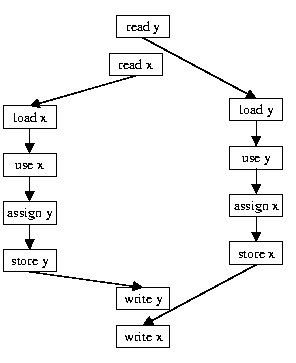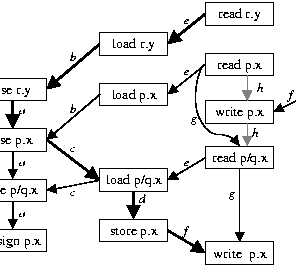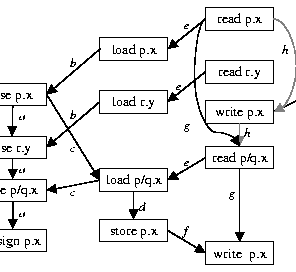


Next: Reality
Up: Fixing the Java Memory
Previous: Introduction
Subsections
In this section, I try to interpret JMM, the existing
Java Memory Model, as defined in Chapter 17 of the Java Language Specification [GJS96].
The same definition also appears in Chapter 8 of the Java Virtual Machine
Specification [LY96].
A number of terms are used in the Java memory model but not
related to Java source programs nor the Java virtual machine. Some of these terms have
been interpreted differently by various people. I have based my understanding
of these terms on conversations with Guy Steele, Doug Lea and others.
A variable refers to a static variable of a loaded class, a field of an
allocated object, or element of an allocated array. The system must maintain
the following properties with regards to variables and the memory manager:
-
It must be impossible for any thread to see a variable before it has been initialized to the default value for the type of the variable.
-
The fact that a garbage collection may relocate a variable to a new memory location
is immaterial and invisible to the memory model.
The existing Java memory model discusses use,
assign, lock and
unlock actions:
-
A use action corresponds to a getfield,
getstatic or array load (e.g., aaload) Java bytecode instruction.
-
An assign action corresponds to a putfield,
putstatic or array store (e.g, aastore) Java bytecode instruction.
-
A lock action corresponds to a monitorenter Java bytecode instruction.
-
A unlock action corresponds to a monitorexit Java bytecode instruction.
The JMM suggests that at thread termination, a thread doesn't
need to write back the results of assigns to main memory.
This is obviously (to me) a bug and I assume it is fixed
by saying that there must be a store associated with the last
assign to a variable in a thread.
The JMM also doesn't force a thread to pushed cached writes
out to main memory before starting a new thread. This has
been acknowledged as a bug.
Due to the double indirection in the Java memory model, it is very
hard to understand. What features does it provide?
Figure 1:
Execution valid for Java only due to prescient stores
 |
Figure 2:
Actions and orderings for Figure 1 without prescient stores (with prescient stores, delete orderings from assign actions to store actions)
 |
Figure 3:
Example showing that reads kill
// p and q might be aliased
int i = p.x
// concurrent write to p.x
// by another thread
int j = q.x
int k = p.x
|
Consider the example
in Figure 1.
Gontmakher and Schuster [GS97] state that
this is an execution trace that is illegal for Java, but they
are incorrect because they do not consider prescient stores [GJS96, §17.8].
Without prescient stores, the actions and ordering constraints required by
the JMM are shown in Figure 2.
Since the write of y is
required to come after the read of x, and the write of x is required to come after
the read of y, it is impossible for both the write of x to come before
the read of x and for the write of y to come before the read of y.
With prescient stores, the store actions
are not required to come after the assign actions; in fact, the
store actions can be the very first actions in each thread. This makes it
legal for the write actions for both x and y to
come before either of the read actions, and for execution to result in a = b = 1.
What the JMM does require is Coherence [ABJ+93]. Informally, for
each variable in isolation, the uses and assigns to that variable
must appear as if they acted directly on global memory in some order
that respects the order within each thread (i.e., each variable in
isolation is sequentially consistent). A proof that the Java memory model
requires Coherence is given in [GS97]. That paper didn't consider
prescient stores, but it doesn't impact the proof that the JMM requires Coherence;
even with prescient stores, the load and store actions for a particular
variable cannot be reordered.
In discussions, Guy Steele stated that he had intended the JMM model to have
this property, because he felt it was too non-intuitive for it not to.
However, Guy was unaware of the implications of Coherence on
compiler optimizations (below).
Coherence means that reads kill
Consider the code fragment in Figure
3
Since p and q
only might be aliased, but are not definitely aliased,
then the use of q.x
cannot be optimized away (if it were known that p
and q pointed to the same object, then it would be legal to replace
the assignments
to j and k with assignments of the value of i).
Consider the case where p and q
are in fact aliased, and another thread
writes to the memory location for p/q.x between the first use of p.x
and the use of q.x; the use of q.x will see the new value.
It will be illegal for the second
use of p.x (stored into k) to get the same value as was stored
into i.
However, a fairly standard compiler optimization would involve eliminating the
getfield for k and replacing it with a reuse of the value stored into i.
Unfortunately, that optimization is illegal in any language that requires
Coherence.
One way to think of it is that since a read of a memory location may cause the
thread to become aware of a write by another thread, it must be treated in the
compiler as a possible write.
In talking with a number of people at OOPSLA98, I found that
most people were not aware of the implications for compilers
of Coherence in the JMM, and at least one shipping commercial Java
compiler violates Coherence.
Figure:
Counter example to JMM  Coherence
Coherence
// p and q might be aliased
int i = r.y
int j = p.x
// concurrent write
// to p.x by another thread
int k = q.x
p.x = 42
|
Figure 5:
JMM actions for Figure 4
 |
Initially, I tried to derive a proof that,
excluding locks and volatile variables,
the Java memory model is exactly Coherence. Instead, I came up with a
counter-example. Consider the code fragment in Figure 4,
and the scenario in which
p and q are aliased (although we are not able to prove it),
and another write happens to update the value of p/q.x between the read
of p.x and the read of q.x, so that the use of p/q.x sees a different
value than the use of p.x. The actions corresponding
this execution, and their ordering constraints, are shown in
Figure 5.
The boxes and arrows in this diagram arise for the following reasons:
- a
- [GJS96, §17.3, bullet 1]: All use and assign actions by a given thread
must occur in the order specified by the program
being executed.
- b
- [GJS96, §17.3, bullet 4]: ... must perform a load before performing
a use
- c
- Since the use of p/q.x sees a different value than the use of p.x,
there must be a separate load instruction for the use of p/q.x,
which must precede the use of p/q.x and follow the use of p.x.
- d
[GJS96, §17.8, bullet 3]: No load of V intervenes between the relocated
[prescient] store and the assign.
- e
[GJS96, §17.3, second list of bullets, 1st bullet]:
For each load, there must be a corresponding preceding read
- f
[GJS96, §17.3, second list of bullets, 2nd bullet]:
For each store, there must be a corresponding following write
- g
[GJS96, §17.2, 2nd bullet]: actions performed by main memory
for any one variable are totally ordered
[GJS96, §17.3, second list of bullets, 3rd bullet]:
edges between load/store actions on a variable V
and the corresponding read/write actions cannot
cross
- h
- Since we consider the situation where p and q are aliased and
the use of p/q.x sees
a different value than the use of p.x, there must have been an intervening
write to p.x by another thread between the load of p.x and the load of p/q.x.
Figure 6:
JMM actions for Figure 4 after re-ordering use of r.y and use of p.x
 |
I showed this example to Guy Steele and he tentatively agreed that
the JMM imposed the constraints shown in Figure 5,
although he did not double check it at length.
This ordering constraints was definitely not intended, and has
a substantial impact on optimizing Java compilers and
on Java programs running on aggressive processor architectures.
In Figure 5
it would be legal for the read r.y action
to occur after the read p.x action. But if we tried to perform this
transformation at the bytecode level (moving the getfield r.y instruction
to after the getfield p.x action), we get the actions shown in
Figure 6. In these set of actions,
it would be legal to perform the read r.y action after the
write p.x action.
So the set of legal transformations on
Java programs are not closed under composition. You can't perform
a transformation at the bytecode level without reasoning about whether
or not there might exist any downstream component that might perform
a reordering that, when composed with your reordering, produces
an illegal reordering of the memory references.
This pretty much
prohibits any bytecode transformations of memory references.
There may be other strange constraints imposed by the existing JMM, but at this
point we switch from trying to decipher the existing JMM to deciding
what features we want in a new Java memory model.



Next: Reality
Up: Fixing the Java Memory
Previous: Introduction
William Pugh

